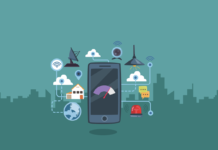What is 5G?
The latest invention 5G network is the fifth generation of cellular technology with enhanced speed and network reliability and expanded the number of connected devices. Built on high-frequency airwaves i.e. high band spectrum, 5G can transmit much more data compared to previous-generation technologies like 2G, 3G or 4G.
Here are some of 5G features that stands out from other mobile networking technologies:
- Better throughput than 4G: Though each wireless network generation has shown an increase in throughput, 5G vs4G throughput and previous generations can be compared by performing 5G speed test. For instance, 5G download speed data for operators ‘T-Mobile’ and ‘AT&T’ is 49.2 Mbps and 60.8Mbps whereas 4G speed is 36.3 Mbps and 37.1 Mbps respectively.
- Upgraded capacity: 5G will be the foundation for IoT development as it has large capacity to handle thousands of devices connected seamlessly. These devices are being used in various applications and use cases in manufacturing, healthcare, personal homes and many more.
- Less response time i.e. latency: With 5G being deployed in various devices to communicate, for e.g. vehicle to things (V2X) communication where vehicles respond to traffic signals faster than human beings, has made possible to handle devices from remote locations in real-time. Further, low latency and high speed is ideal for AR/VR applications and give users an immersive experience.
- Bandwidth is increased: This feature will let 5G networks to manage a large amount of data, permitting greater optimization of network traffic and seamlessly handling of a spike in network usage. In today’s business world, enterprises deal with lots of information coming from different sources like customers, suppliers, in-house departments and need to be processed for gaining insights. 5G networks clubbed with Big Data analytics can assist businesses in extracting meaningful insights from large volumes of data.
5G applications in different areas with examples
- Ultra-Reliable Low Latency Communication (uRLLC): For mission-critical services, businesses are using this technology to gain response in just a fraction of a second and take necessary actions accordingly.
- Use Case: uRLLC enables factory automation in various industries including pharmaceuticals, semiconductors, metals, electrical assembly, etc. These applications are enabled at low end-to-end latency for e.g. less than 0.5 ms (milliseconds) at a highly reliable Block Rate (BLER).
- Massive Machine Type Communication (mMTC): Such communication standard provides internet access in order to sense and monitor connected devices.
- Use Case: mMTC caters to connectivity across a large number of devices for smart home that includes connected home appliances, smart cities, smart watches, fitness bands, etc.
- Enhanced Mobile Broadband (eMBB): This is highly recommended in case of applications that require high data rates such as virtual reality (VR), large-scale video streaming.
- Use Case: From delivering High Definition (HD) multimedia content for entertainment to supporting cloud-based apps for businesses, eMBB has the capacity to deliver outstanding immersive VR and AR with real-time video monitoring with 3600 video experience. It will also interact with participants in real-time assisting them with real-time language translation if participants are from different natives.
Case studies of leading MNOs working on 5G
Some of the leading telecom players are taking strategic initiatives to be at the forefront of the 5G race:
- Verizon has achieved few milestones in the 5G competition with the development of a virtual testing lab to craft innovative 5G solutions and applications used for personal and professional purpose. It expanded its services to San Diego, a city in the state of California, and is 35th city to be imparted with mobile service.
- Telecom operators are using tools like 5G smartphone and Fujitsu 5G NR base station to perform 5G network testing. Qualcomm Technologies collaborated with Fujitsuto establish 5G NR data call services with the carrier aggregation of 5G sub-6 GHz on 3.5 and 4.9 GHz bands on a non-standalone architecture.
- Ericssonrecently made 91 5G agreements with specific telecommunication providers commercially where 36 networks are live networks. It is keen oi capitalize on different market opportunities as it is increasing its focus on 5G development with a belief that 5G standardization is the foundation for industrial digitization in the upcoming years.
Summing up
5G is being deployed on a large scale, enabling various use cases across different verticals with greater throughput, capacity and shorter lag time benchmarked with legacy wireless networks like 4G. The evolution of 5G promises to transform businesses as they move forward and implement this new-age technology to be at the forefront of 5G racein the competitive market. This enables them to improve their productivity, eases business operations thereby increasing their ROI.








